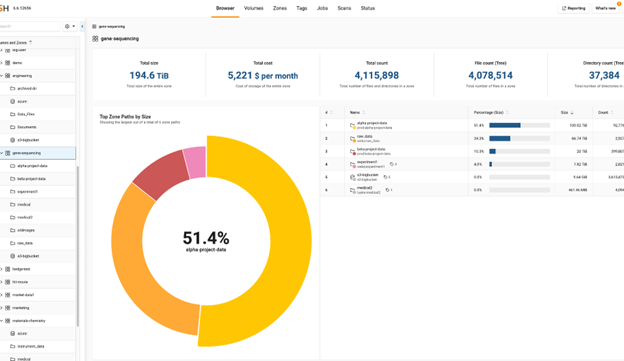We recently reported how Harvard University’s Faculty of Arts and Sciences Research Computing (FASRC) group scored major ROI and research data management wins using a combination of Starfish and ColdFront to create a chargeback system for their research teams’ storage. FASRC is headed up by Raminder Singh, Senior Director of Data Science and Research Facilitation.
Further innovation: a chargeback revenue model that funds better data management
Along the way, what started as a way to recover costs became a catalyst for a much broader transformation—one empowered by the unique data visibility and automation capabilities of Starfish Storage. Beyond the technical innovation that went into creating the chargeback program, Raminder Singh included a second innovation: the revenue model. The FASRC chargeback revenue model included not just the cost of storage hardware, not just the cost of storage hardware, but the all in costs including data center space and management software. Most importantly, it included the cost of funding a pivotal new role: the Research Data Manager. This role was created to help researchers take control of their storage and develop sustainable best practices for data management.
To fill the role of FASRC’s first Research Data Manager, Raminder brought in Sarah Marchese who now leads personalized data management efforts across more than 600 labs and projects. Under her and Raminder’s leadership, the program brings in over $2M in chargeback revenue a year.
Data management is now the job of every researcher
“Researchers don’t often learn about data management as part of their standard practices,” Sarah explains. “They require additional tools to visualize and understand what data they have and how much storage space they’re consuming. The trend is moving away from simply publishing an article—your data is part of your deliverable. By empowering stakeholders to view essential information about their data through an easily accessible dashboard, they can proactively manage their storage usage, and make decisions about what data needs to be retained, archived, consolidated, or removed.”
The financial motivation created by the chargeback system brings researchers to the table—but once they’re there, Sarah helps them develop comprehensive data management strategies, including archiving, classification, data sharing and cleanup.
With Starfish, researchers now have their own data dashboard

A screenshot of a Starfish Storage Zones dashboard.
Harvard’s FASRC chargeback solution uses the unique functionality of Starfish to provide researchers a self-service dashboard. A Starfish feature called Zones allows directory space from anywhere in the storage environment to be grouped into a logical entity that means something to the users. For instance, a Zone could be all of the files for a specific lab, a project, a core facility, a research group, a department, etc.
Users are assigned access to Zones based on user IDs and group IDs. When they log in, they see their Zones and the contents of each zone. Rather than being presented with the complexity of the entire storage environment, users see all related data in context, along with analytics such as file counts, storage consumption, last access times, and more, across multiple file systems, and without regard for where the files are physically stored. This allows researchers for the first time to visualize and manage their own storage footprint. With the Starfish dashboard as the centerpiece, Sarah can now engage researchers in meaningful conversations about their data strategy.
Enabling easier data migrations to long term storage
Having worked in the research data management field for over 8 years, Sarah understands one of the biggest barriers to research data management is the level of effort and time required to organize and maintain data storage. Migrating between storage platforms can be especially challenging, necessitating additional modifications to meet platform restrictions.
To enable easier transfers to the Northeast Storage Exchange (NESE) Tape environment, a local cold storage offering with the Massachusetts Green High Performance Computing Center (MGHPCC), Sarah collaborated with the Starfish engineering team to design a workflow that could be triggered when users want to transfer directories or a set of files. Users apply a tag to the directory path in the user interface, and Starfish takes it from there, zipping and compressing files into the right format for NESE. This enabled researchers to migrate data to cold storage and meet the strict stipulations about dataset size and file count. Other projects currently in the works between Starfish and FAS Research Computing include greater integration with the Globus platform and improving reporting capabilities.
The long term result: Storage consumption has flattened
Insight from the chargeback solution has allowed FASRC leadership to make informed, strategic data management decisions. It’s also had another positive result that links back to the original vision: Storage growth is flattening. The Research Computing team hasn’t received any last-minute emergency storage requests in over a year—a rare and welcome minor miracle. Raminder attributes this to the combined impact of Starfish, ColdFront, and dedicated staff support—especially Sarah’s ability to bring best practices directly to labs.
The program continues to drive data management innovation
The story of Starfish and Harvard FAS Research Computing is one of transformation and innovation—technical, financial, and cultural.
As Raminder puts it: “I want our researchers to be able to use best practices in data management. That means solutions that solve storage problems at the individual and at grant level. We’re working toward this vision and asking our partners like Starfish and ColdFront to innovate alongside us.”
More adoption means more visibility, better storage hygiene, and lower costs. Sarah sees a real transformation in data management happening at Harvard, and is hoping other schools and research centers can take advantage of the developments at Harvard FAS. Stay tuned for Chapter Three.
Many thanks to Raminder Singh, Senior Director of Data Science and Research Facilitation and Sarah Marchese, Research Data Manager at Harvard University’s Faculty of Arts and Sciences Research Computing (FASRC) for collaborating with Starfish on this story.
Want to learn how Starfish can help fuel storage innovation in your enterprise? Give us a shout.
